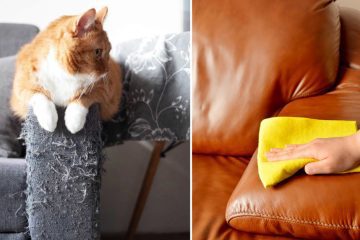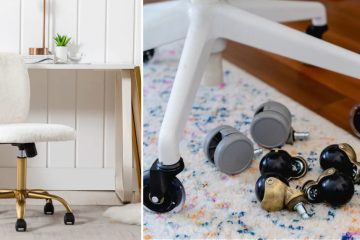Do you have a wicker chair that looks old and worn out? Don’t throw it away! You can fix it yourself with some simple tools and materials. Wicker is a type of furniture that is made from woven natural or synthetic materials. It is durable, versatile, and beautiful, but it can also have some problems over time, such as loose ends, broken reeds, fading color, and sagging cushions. In this blog post, you will learn how to fix wicker chair seat in 5 easy steps. You will be able to restore your wicker chair seat to its former glory and enjoy it for many more years. Let’s get started!
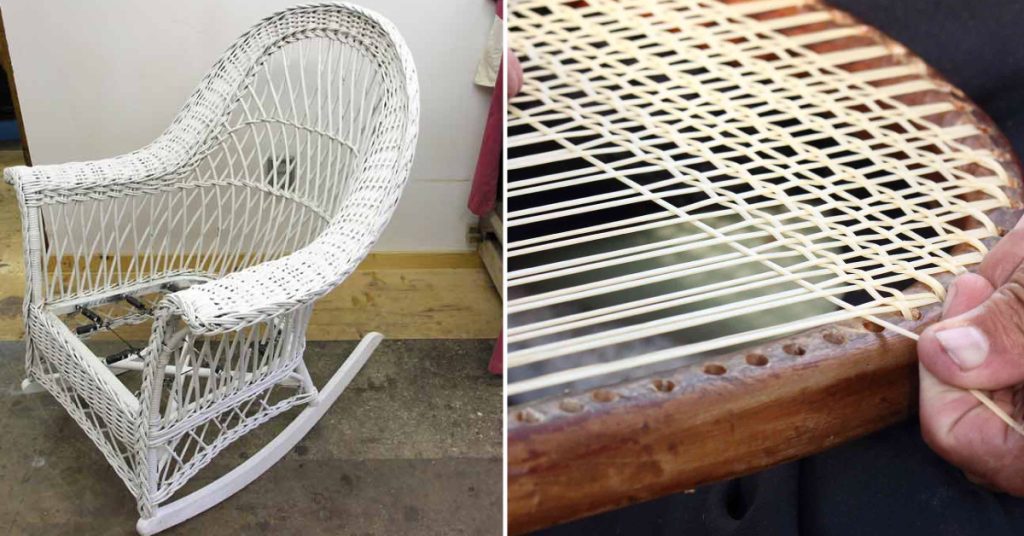
Key Takeaways:
- Remove the old, damaged wicker seat
- Cut new wicker material to size for the seat
- Attach the new wicker seat to the chair frame using glue and nails/tacks
- Optionally paint and varnish the new seat
- Clean and fluff the chair cushions
Materials and Tools You’ll Need
You will need the following materials and tools to fix your wicker chair seat:
- Wicker strips or reeds: You can buy these from craft stores or online retailers. Make sure they match the color and size of your existing wicker furniture.
- Wood glue: You will need this to secure the loose ends and attach the new seat to the frame. Choose a strong glue that is suitable for wood and wicker materials, such as PVA glue or epoxy resin.
- Hammer: You will need this to drive nails or carpet tacks into the frame.
- Nails or carpet tacks: You will need these to further secure the new seat to the frame. Choose nails or tacks that are small enough to fit into the wicker pattern without damaging it.
- Saw: You will need this to cut the new seat to size. Use a sharp saw that can cut through wicker without splintering it.
- Pliers: You will need these to pull out the broken strands of wicker and remove any nails or tacks from the old seat.
- Toothpicks: You will need these to apply glue to the loose ends and fill in any gaps in the wicker pattern.
- Paint and brush (optional): You can use these to paint your new seat with your desired color. Choose a paint that is suitable for wicker furniture, such as acrylic or latex paint.
- Resin-based primer (optional): You can use this to prime your new seat before painting it. This will help the paint adhere better and last longer.
- Clear varnish or polyurethane topcoat (optional): You can use this to protect your new seat from future damage. This will add a glossy finish and prevent fading, cracking, or peeling of the paint.
- Bleach solution or dish soap mixture (optional): You can use these to clean and disinfect your cushions. This will help remove any odors, stains, or dirt from them.
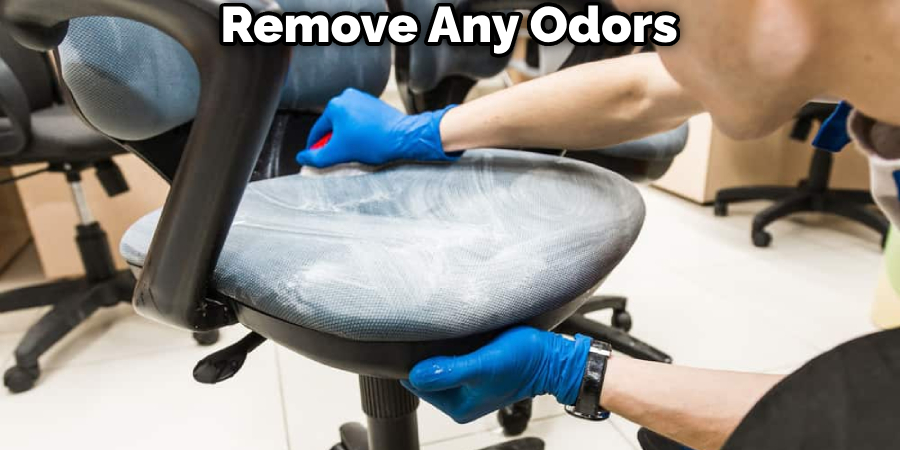
5 Easy Steps for How to Fix Wicker Chair Seat
Now that you have all the materials and tools ready, you can start fixing your wicker chair seat. Follow these steps carefully and make sure you work in a well-ventilated area.
Step 1: Remove the Old Seat
The first step is to remove the old seat from your wicker chair. To do this, you will need to cut or pull out the damaged wicker strands from the seat frame. Use pliers to grip the strands and pull them out gently. Be careful not to damage the frame or any other parts of the chair. If there are any nails or tacks holding the old seat in place, use pliers to remove them as well. Keep them aside for later use. You may also need to remove any cushions or covers from the old seat before removing it. Clean them separately using a bleach solution or dish soap mixture (see Step 5).
Step 2: Cut a New Seat to Size
The next step is to cut a new seat to size using your wicker strips or reeds. To do this, you will need to measure the size of your seat frame and mark it on your wicker strips or reeds. Use a saw to cut along the marked lines. Make sure you cut enough strips or reeds to cover the entire seat frame. Before weaving them in, soak them in warm water for 15 minutes. This will make them more flexible and prevent cracking.
Step 3: Attach the New Seat to the Frame
The third step is to attach the new seat to the frame by weaving the wicker strips or reeds into the existing pattern. To do this, you will need to use wood glue and nails or carpet tacks. Start by applying some glue to the ends of the wicker strips or reeds and inserting them into the holes or slots on the seat frame. Use a toothpick to apply the glue and avoid using too much. Then, weave the wicker strips or reeds in and out of the frame, following the original pattern. Make sure you keep the tension even and avoid gaps or overlaps.
When you reach the end of a strip or reed, cut off any excess and glue it to the frame. Use a toothpick to fill in any gaps with glue. To further secure the new seat to the frame, use a hammer to drive nails or carpet tacks into the wicker at regular intervals. Be careful not to overtighten them or damage the wicker. Repeat this process until you cover the entire seat frame with a wicker.
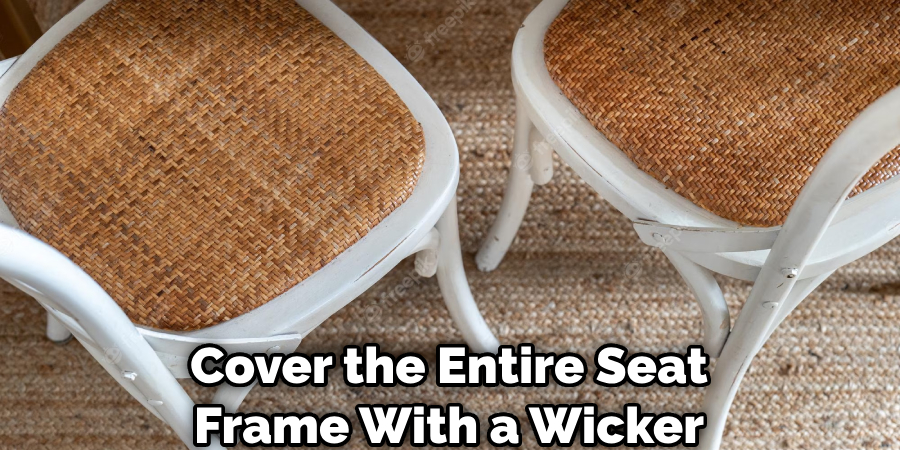
Step 4: Decorate the New Seat (Optional)
The fourth step is to decorate your new seat with paint if you want to change its color or appearance. To do this, you will need to use paint, brush, resin-based primer, and clear varnish or polyurethane topcoat. Before painting your new seat, make sure it is completely dry and free of dust or dirt. Then, apply a coat of resin-based primer to your new seat using a brush. This will help the paint adhere better and last longer.
Let the primer dry for at least an hour before applying the paint. Choose a paint that is suitable for wicker furniture, such as acrylic or latex paint. Use a small brush to apply the paint evenly and avoid drips and spills on the cushions or floor. You may need to apply two coats of paint for better coverage and color. Let each coat dry for at least an hour before applying the next one.
After painting your new seat, apply a coat of clear varnish or polyurethane topcoat using a brush. This will protect your new seat from future damage and add a glossy finish. Let it dry for at least an hour before using your chair.
Step 5: Clean and Restore the Cushions (Optional)
The fifth and final step is to clean and restore your cushions if they are dirty or stained. To do this, you will need to use a bleach solution or dish soap mixture. Remove any covers from your cushions and wash them separately in warm water with mild detergent. Rinse them well and let them air dry. To clean your cushions, mix one part bleach with four parts water in a bucket or spray bottle. Alternatively, you can mix one teaspoon of dish soap with two cups of warm water in a spray bottle.
Spray the solution onto your cushions and let it sit for 15 minutes. Then, use a sponge or cloth to scrub away any dirt or stains. Rinse your cushions well with clean water and let them air dry. To restore your cushions, fluff them up by shaking them gently or hitting them with your hands. This will make them more comfortable and fluffy.
You Can Also Check Out to Fix a Wicker Chair.

6 Tips for How to Fix Wicker Chair Seat
Here are some tips for fixing your wicker chair seat:
- Use a map lamp or flashlight to see the loose ends clearly when gluing them back into the wicker pattern.
- Use a strong glue that is suitable for wood and wicker materials, such as PVA glue or epoxy resin.
- Be careful not to overtighten the nails or carpet tacks when attaching the new seat to the frame. This can damage the wicker and cause it to crack or break.
- Use a small brush to apply the paint evenly and avoid drips and spills on the cushions or floor.
- Use a clear varnish or polyurethane topcoat to protect your new seat from future damage. This will prevent fading, cracking, or peeling of the paint.
- Keep your wicker furniture indoors or under a shade to prevent damage from direct sunlight, rain, or humidity.
You Can Check It Out to Make a Chair Pillow.

FAQs About How to Fix Wicker Chair Seat
Can You Repair Wicker Seat?
Yes, wicker seats can be repaired. You can fix them by securing loose ends with glue, replacing broken pieces with soaked replacement fibers, and finishing with protective treatment like olive oil or varnish. For extensive damage or expert assistance, consider professional wicker repair services.
What Kind of Glue to Use on Wicker Furniture?
When repairing wicker furniture, it’s recommended to use wood glue for securing loose ends and reattaching broken strands.
What is Wicker Made of?
Wicker furniture can be made from various materials. Traditionally, it utilized natural materials like rattan, bamboo, reed, and willow for indoor use. For outdoor furniture, synthetic materials like vinyl, PVC, and polyethylene are preferred, often woven around aluminum frames for durability. The choice of material depends on whether the furniture is intended for indoor or outdoor use, with synthetic materials being better suited to withstand outdoor conditions.
Conclusion
By following this guide, you will learn how to fix wicker chair seat in 5 easy steps. By doing this project yourself, you have saved money, time, and resources that you would have spent on buying a new chair or hiring a professional. You have also preserved the quality and beauty of your wicker furniture and made it look new again. We hope you enjoyed this guide and found it helpful.

